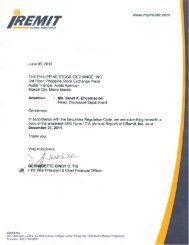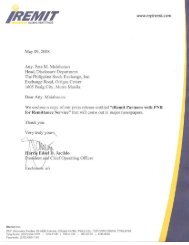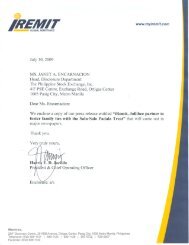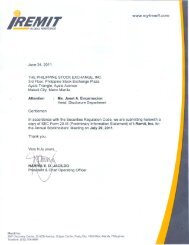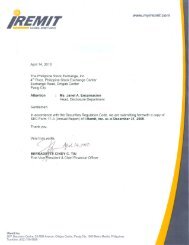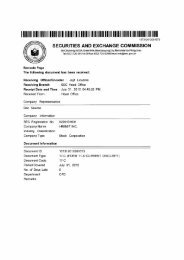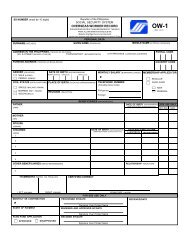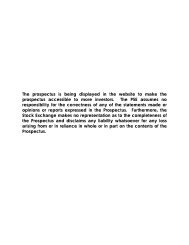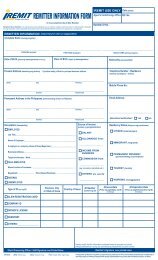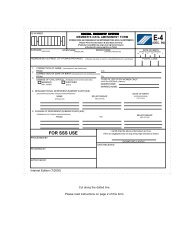SEC Form 20-IS - iRemit Global Remittance
SEC Form 20-IS - iRemit Global Remittance
SEC Form 20-IS - iRemit Global Remittance
Create successful ePaper yourself
Turn your PDF publications into a flip-book with our unique Google optimized e-Paper software.
- 6 -<br />
takes the form of a guarantee over the transferred asset is measured at the lower of the original<br />
carrying amount of the asset and the maximum amount of consideration that the Parent Company<br />
could be required to repay.<br />
Financial liability<br />
A financial liability is derecognized when the obligation under the liability is discharged,<br />
cancelled or has expired. When an existing financial liability is replaced by another from the same<br />
lender on substantially different terms, or the terms of an existing liability are substantially<br />
modified, such an exchange or modification is treated as a derecognition of the original liability<br />
and the recognition of a new liability, and the difference in the respective carrying amount of a<br />
financial liability (or part of a financial liability) extinguished or transferred to another party and<br />
the consideration paid, including any non-cash assets transferred or liabilities assumed, shall be<br />
recognized in the parent company statement of income.<br />
Offsetting Financial Instruments<br />
Financial assets and financial liabilities are offset and the net amount reported in the balance sheet<br />
if, and only if, there is a currently enforceable legal right to offset the recognized amounts and<br />
there is an intention to settle on a net basis, or to realize the asset and settle the liability<br />
simultaneously.<br />
Impairment of Financial Assets<br />
The Parent Company assesses at each balance sheet date, whether there is an objective evidence<br />
that a financial asset or group of financial assets is impaired. A financial asset or a group of<br />
financial assets is deemed to be impaired if, and only if, there is an objective evidence of<br />
impairment as a result of one or more events that has occurred after the initial recognition of the<br />
asset (an incurred ‘loss event’) and that loss event (or events) has an impact on the estimated<br />
future cash flows of the financial asset or the group of financial assets that can be reliably<br />
estimated. Evidence of impairment may include indications that the borrower or a group of<br />
borrowers is experiencing significant financial difficulty, default or delinquency in interest or<br />
principal payments, the probability that they will enter bankruptcy or other financial<br />
reorganization, and where there are observable data that indicates that there is a measurable<br />
decrease in the estimated future cash flows, such as changes in arrears or economic conditions that<br />
correlate with defaults.<br />
Financial assets carried at amortized cost<br />
For financial assets carried at amortized cost, the Parent Company first assesses whether objective<br />
evidence of impairment exists individually for financial assets that are individually significant, or<br />
collectively for financial assets that are not individually significant.<br />
If there is objective evidence that an impairment loss has been incurred, the amount of the loss is<br />
measured as the difference between the asset’s carrying amount and the present value of the<br />
estimated future cash flows (excluding future credit losses that have not been incurred). The<br />
carrying amount of the asset is reduced through the use of an allowance account and the amount of<br />
loss is charged to the parent company statement of income. Interest income continues to be<br />
recognized based on the original EIR of the asset. Receivables, together with the associated<br />
allowance accounts, are written off when there is no realistic prospect of future recovery and all<br />
collateral has been realized. If subsequently, the amount of the estimated impairment loss<br />
decreases because of an event occurring after the impairment was recognized, the previously<br />
recognized impairment loss is reduced by adjusting the allowance account. If a future write-off is<br />
later recovered, any amounts formerly charged are credited to profit or loss.<br />
*SGVMC116501*



